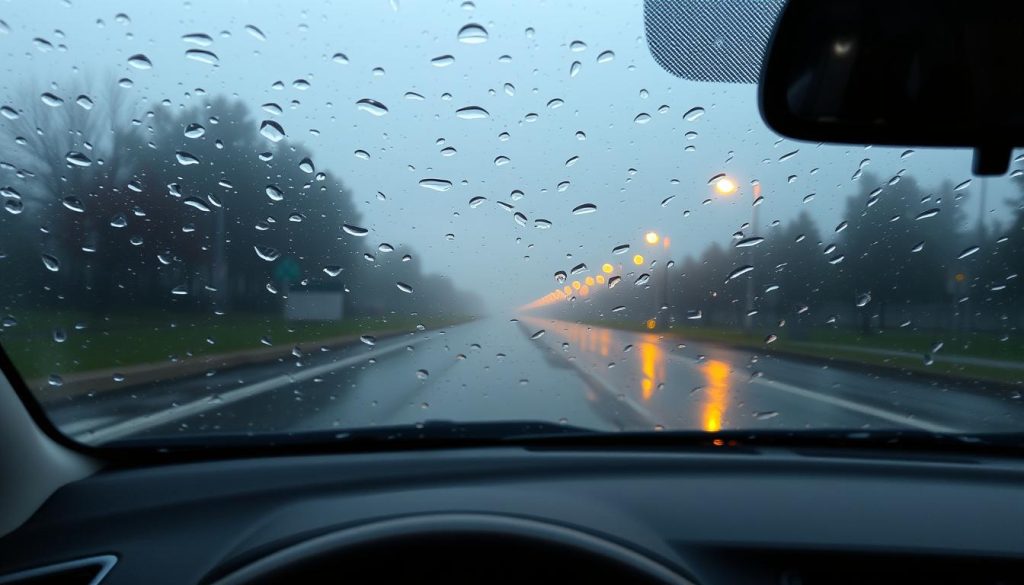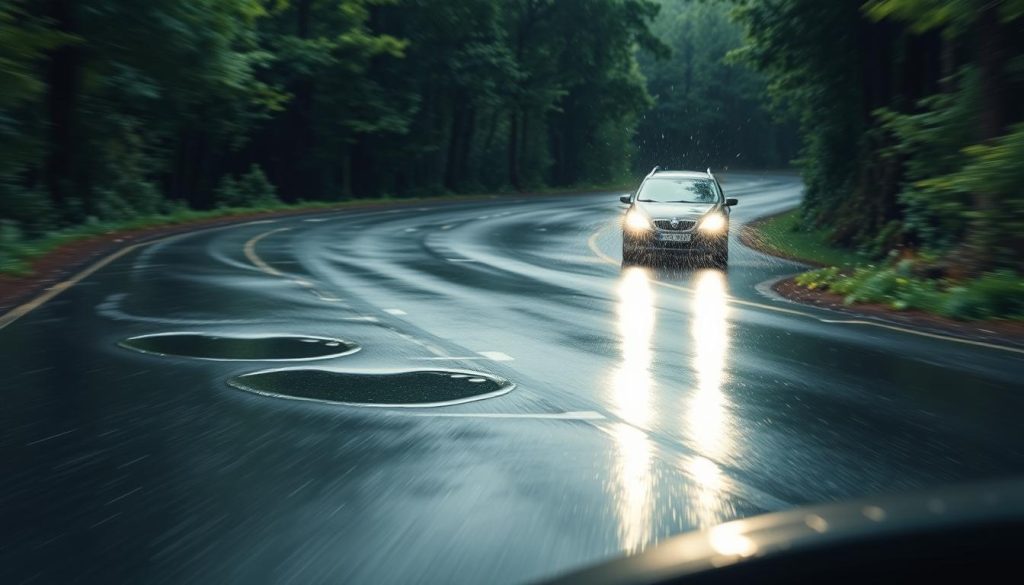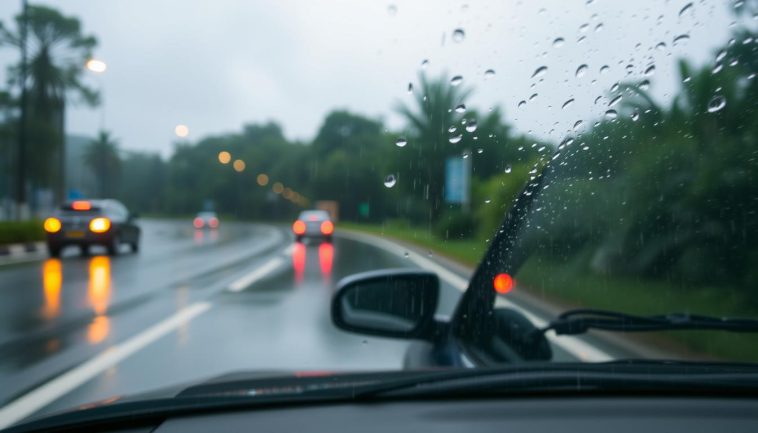anxietywhendriving.com highly recommends The Driving Fear Program to overcome your Driving Anxiety 90 Days Money Back Guarantee!
-->Click Here<--

Did you know that 90% of drivers feel anxious when driving in the rain? A study by the National Safety Council found this out. The fear of losing control or not seeing well can make people very scared. But, with the right techniques and mindset, you can face your fears and feel confident again.
Key Takeaways
- Understand the potential causes and triggers of fear when driving in the rain
- Learn essential safety tips for navigating wet roads, including adjusting driving techniques and maintaining visibility
- Discover mindfulness and relaxation exercises to manage anxiety and build confidence behind the wheel
- Explore strategies for overcoming hydrophobia and driving phobias through exposure therapy
- Prepare your vehicle and adopt defensive driving skills to safely confront inclement weather conditions
Understanding the Fear of Driving in the Rain
Driving in the rain can be scary for many. This fear might come from past bad experiences, phobias, or anxiety. Knowing what causes and symptoms of this fear helps us understand the struggles of those who find driving in the rain hard.
Potential Causes and Triggers
A bad experience on the road, like a car accident, can cause driving phobia. It makes people feel like they’re in danger and can’t control their car. This can lead to anxiety and panic when they face similar situations again.
Phobias like agoraphobia (fear of open spaces) or claustrophobia (fear of enclosed spaces) can also make driving scary. The car feels like a small, dangerous place. Anxiety disorders, like generalized anxiety disorder or social anxiety disorder, can make driving fears worse.
Common Symptoms and Anxieties
People with driving phobia may feel panicked, disoriented, and short of breath. They might want to get out of the car fast. They worry about losing control, getting into an accident, or not finding a safe place to stop.
Driving anxiety can be triggered by many things. It might be highways, bridges, heavy rain, or poor visibility. The fear of losing control, slipping on the road, and not seeing well adds to the stress.
“The fear of driving in the rain is a common challenge, but with understanding and the right coping strategies, it can be overcome.”
Safety Tips for Driving in Rainy Conditions
Driving in the rain can be scary, but you can stay safe with the right tips. The AAA, a top car group, shares important advice for driving in wet weather.
Adjusting Your Driving Techniques
When roads are slippery, you need to change how you drive. Don’t use cruise control, as it can make you lose control. Instead, slow down and keep a safe distance to brake better.
If your car starts to hydroplane, take your foot off the gas slowly. Don’t brake or steer hard. This helps you get back in control and avoid accidents.
Maintaining Visibility and Traction
- Make sure your windshield wipers work well to clear water.
- Check your tire tread depth and air pressure often for better grip.
- Think about getting all-weather or rain tires for better performance in wet weather.
By using these safe driving techniques in the rain, you can drive confidently. Adjust your speed and braking for wet roads. And keep your visibility and traction up. This way, you’ll reach your destination safely.
Overcome Fear of Driving in the Rain
Many people can beat their fear of driving in the rain. By using different strategies, drivers can overcome their fear and feel more confident on wet roads.
Exposure therapy is a good way to start. It means facing your fear little by little, first in a safe place and then in real rain. Having a friend or family member with you can also help you get more confident on wet roads.
Using relaxation techniques like deep breathing and visualization can also help. These methods help manage the anxiety that comes with driving in bad weather. By focusing on your breathing and imagining yourself driving safely, you can learn to handle driving anxiety.
Going to special driving courses is another great idea. These courses teach you how to drive better in the rain. You’ll learn about adjusting your driving, keeping your visibility and traction, and spotting dangers.
“The key to overcoming the fear of driving in the rain is to take it one step at a time, with patience and a willingness to practice. By building confidence and developing the right mindset, drivers can conquer their hydrophobia and enjoy the journey, rain or shine.”
Defensive Driving Skills for Inclement Weather
Driving on wet roads safely needs special skills. It’s about anticipating hazards and risks in rainy weather. Knowing defensive driving techniques for wet roads helps drivers handle weather challenges better.
Anticipating Hazards and Potential Risks
Driving in the rain means staying alert and watching the road. Look out for reduced visibility, hydroplaning risks, and unpredictable other drivers. By assessing and mitigating risks while driving in the rain, drivers can make smart choices and act fast when needed.
- Keep a safe distance to brake longer.
- Slow down for less traction and visibility.
- Always look for hazards like water, debris, or other cars.
- Be ready to stop or change lanes quickly if others do.
“Anticipating potential hazards and responding proactively is the key to safe driving in rainy conditions.”
Developing these defensive driving skills for inclement weather makes driving in the rain safer. Drivers can feel more confident and reduce risks.
Mindfulness and Relaxation Techniques
Overcoming the fear of driving in the rain needs a mix of strategies. Mindfulness and relaxation techniques are very helpful. They help drivers manage their anxiety and stay focused in bad weather.
Breathing Exercises and Visualization
Deep, controlled breathing is a great strategy. Slow, deep breaths calm the mind and body. This reduces driving anxiety symptoms. Visualization also helps. It lets drivers imagine themselves driving safely and confidently.
- Practice deep breathing, inhaling for 4 seconds, holding for 4 seconds, and exhaling for 6 seconds.
- Visualize yourself confidently and safely navigating rainy roads, using windshield wipers effectively, and maintaining control of your vehicle.
- Combine breathing exercises and visualization for a powerful one-two punch against driving anxiety.
Regular use of these techniques can greatly help manage driving fears and anxieties. This is especially true when driving in the rain.
“I used to dread driving in the rain, but after incorporating breathing exercises and visualization into my routine, I feel much more in control and confident behind the wheel. It’s made a world of difference.”
| Mindfulness Technique | Benefits for Driving Anxiety |
|---|---|
| Deep Breathing | Calms the mind and body, reducing physiological symptoms of anxiety |
| Visualization | Helps drivers mentally rehearse successful, safe driving experiences |
| Meditation | Promotes focus, presence, and emotional regulation while driving |
By adding these mindfulness and relaxation techniques to your driving routine, you can overcome your fear of driving in the rain. You’ll regain confidence on the road.
Building Confidence Through Exposure Therapy
Overcoming the fear of driving in the rain is tough, but exposure therapy works well. It involves facing your fears slowly in a safe place. This helps people gain confidence and skills to beat their driving phobia.
Drivers start by slowly getting used to driving in the rain with a therapist or a trusted friend. This slow step helps them face their fears and feel safe again on the road.
Driving in the rain helps people learn to handle their anxiety. As they get better, they feel more at ease driving. This makes them more confident and comfortable.
“Facing your fears in a controlled and supportive environment is the key to overcoming a driving phobia. Exposure therapy empowers individuals to take back control of their driving experience.”
Exposure therapy does more than just help with driving in the rain. It also teaches defensive driving skills. These include spotting dangers and keeping the car safe on wet roads.
This step-by-step method builds confidence and strength. It helps drivers face their fears and enjoy driving again.

Coping Strategies for Anxiety Relief
People with a fear of driving in the rain can find relief. They can use exposure therapy and relaxation techniques. It’s also important to develop coping strategies to manage their anxiety.
Identifying and challenging negative thoughts is a key part of this. These thoughts often fuel their driving-related fears.
Identifying and Challenging Negative Thoughts
Drivers with rain anxiety might think the worst, like accidents or being stuck in a storm. They might also doubt their driving skills and judgment. By spotting these irrational thoughts and replacing them with realistic ones, drivers can feel more confident in rainy weather.
- Identify specific negative thoughts, such as “I’m going to lose control of my car” or “I won’t be able to see the road clearly.”
- Challenge these thoughts by asking for evidence, considering alternative explanations, and focusing on past experiences where you successfully navigated rainy weather.
- Replace negative thoughts with affirmative, empowering statements like “I have the skills to drive safely in the rain” or “I’ve handled rainy conditions before, and I can do it again.”
Using these coping strategies for driving anxiety, identifying and challenging negative thoughts about driving in the rain, and techniques for anxiety relief while driving can help. They can help individuals overcome their fear of driving in wet weather and regain control on the road.
“The greatest weapon against stress is our ability to choose one thought over another.” – William James
Overcoming Hydrophobia and Driving Phobias
The fear of driving in the rain, known as hydrophobia, is often tied to other driving fears. These include agoraphobia, claustrophobia, or a fear of accidents. It’s key to tackle the fears and anxieties to beat these phobias and feel confident driving.
Exposure therapy is a good way to face these fears. It means starting with small steps, like driving in light rain. As you get more comfortable, you can handle more intense rain. Also, using mindfulness and relaxation techniques can help calm you down when driving gets tough.
Learning defensive driving skills is also important. It helps you stay safe and feel more in control. Skills like keeping a clear view, adjusting speed, and knowing what might happen next can make driving in bad weather less scary.
| Strategies for Overcoming Driving Phobias | Benefits |
|---|---|
| Exposure Therapy | Gradually confront and overcome fears in a controlled environment |
| Mindfulness and Relaxation Techniques | Manage anxiety and promote a sense of calm during challenging driving situations |
| Defensive Driving Skills | Feel more in control and less anxious about navigating inclement weather |
With the right help and approach, you can manage your anxiety. You can drive safely, even in tough weather. This way, you can overcome your hydrophobia and driving phobias.
Safe Driving in Rainy and Wet Conditions
Driving in the rain needs a careful plan. You must change how you drive and make sure your car is ready. By doing these things, you can drive safely in the rain and avoid dangers.
Essential Vehicle Maintenance and Preparation
Before you go out in the rain, check your car’s important parts:
- Windshield wipers: Make sure they work well to clear water from your windshield.
- Tire tread and pressure: Good tread and the right pressure help you grip the road.
- Lighting: Check that all lights are on to help you see and be seen.
Looking over these key areas can really help. It makes your car ready for bad weather and keeps you safe on wet roads.

It’s also important to change how you drive in the rain. Drive slower, leave more space between you and others, and don’t brake or turn sharply. This helps you stay in control and drive safely in wet weather.
“The best way to stay safe on the road is to be proactive in both your vehicle’s maintenance and your driving habits.”
By getting your car ready and driving smart, you can handle rainy and wet conditions safely. You’ll get to your destination without trouble.
Conclusion
Overcoming the fear of driving in the rain needs a full approach. It must tackle both the emotional and practical sides of this challenge. By understanding the fear’s roots, learning safe driving, and practicing relaxation, people can feel confident again.
Key steps for safe driving in bad weather include adjusting how you drive. Also, keep your visibility and traction up. Use defensive driving and mindfulness to stay calm. These steps help drivers beat their rain driving fear.
With the right tools and support, anyone can conquer their fear of driving in the rain. This lets drivers feel safe and strong on the road. By using these techniques and growing their strength, people can start their trips with confidence. They’re ready to handle any weather with skill and calm.
FAQ
What are the potential causes and triggers for the fear of driving in the rain?
Verywell Mind says the fear of driving in the rain comes from many places. It can be from past scary experiences, phobias, or anxiety disorders. Specific situations or general worries about losing control or accidents can also trigger it.
What are the common symptoms of driving anxiety and phobia?
Symptoms include panic, feeling lost, short breath, and wanting to get out of the car. These can happen from specific driving situations or general safety worries.
What are some safety tips for driving in the rain?
AAA has tips for safe driving in the rain. Avoid using cruise control and slow down to avoid hydroplaning. Keep a safe distance from the car in front of you. Knowing how to handle a skid is also key.
Make sure your car is ready for wet roads. Check your windshield wipers and tire pressure. This improves visibility and grip on wet roads.
How can I overcome the fear of driving in the rain?
It’s possible to beat the fear of driving in the rain. Exposure therapy helps by facing your fears slowly. Driving courses and practicing with someone you trust can also help.
Using relaxation techniques like deep breathing and visualization can help manage anxiety. These methods can make driving in bad weather easier.
How can I develop defensive driving skills for wet road conditions?
To drive safely on wet roads, you need to be alert and prepared. Watch for hazards like reduced visibility and hydroplaning. Keep a safe distance and adjust your speed and steering as needed.
What mindfulness and relaxation techniques can help with the fear of driving in the rain?
Mindfulness and relaxation techniques are very helpful. Deep breathing can calm your mind and body. Visualization can help you imagine driving safely.
Practicing these techniques can make you more focused and calm when driving in bad weather.
How can exposure therapy help overcome the fear of driving in the rain?
Exposure therapy is a proven way to face and overcome driving fears. It involves slowly getting used to driving in the rain with support. This builds confidence and skills.
It helps challenge negative thoughts and beliefs about driving in bad weather. This can help you feel safer and more in control.
What coping strategies can help manage anxiety when driving in the rain?
Besides therapy and relaxation, coping strategies are important. Identify and challenge negative thoughts that make you anxious. Replace them with more realistic and positive ones.
This can help reduce anxiety and make driving in the rain less scary.
How is the fear of driving in the rain (hydrophobia) related to other driving-related phobias?
Hydrophobia, or the fear of driving in the rain, is often linked to other driving fears. These include agoraphobia, claustrophobia, or a fear of accidents. Treating the root cause of these fears is key to overcoming hydrophobia and gaining confidence.
What steps can I take to ensure my vehicle is prepared for driving in the rain?
To drive safely in the rain, adjust your driving and make sure your car is ready. Check your windshield wipers, tire tread and pressure, and lights. This improves visibility.
Slow down, increase your following distance, and avoid sudden stops or sharp turns. These steps help you stay in control and feel more confident.
anxietywhendriving.com highly recommends The Driving Fear Program to overcome your Driving Anxiety. 90 Days Money Back Guarantee!
-->Click Here<--

